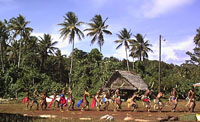 January 31, 1999 January 31, 1999
It was men's dances. Three sets of them --- two standing dances that get pretty raunchy, and a sitting dance that is just arm and upper torso movements. Boy, those guys need a lot of work yet to get the dances down. It was kind of funny because they would run into one another, get way out of sync and so on. I think the sitting dance is probably the hardest. John Tun took me to the practice. He was saying that in order to do the sitting dance, you had to really know the chant that goes with it, because that is the dance. All the movements are in the chant --- the way your hand would flutter, or turn, how you would move your head and so on.
Interestingly, the men sitting and watching were chanting along with the dancers, especially in the sitting dance. And they were doing the movements as an aid to the dancers.
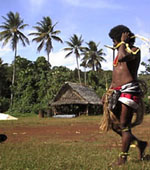 |
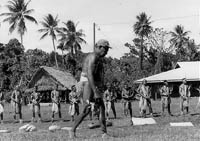 |
| Then there are three photos from the practice: one showing the guys running into one another; another on their break between dances; and another of Chief William Yad --- chief of Gachpar --- who gave his permission for me to watch the practice. |
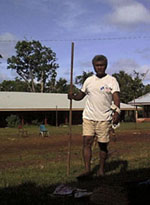 It seems that while practices are open on occasion (like this one) to anyone to watch, that "anyone" usually does not include outsiders. Local people generally get upset if people from the outside come and watch --- but if you have permission from the chief, it makes a big difference. It seems that while practices are open on occasion (like this one) to anyone to watch, that "anyone" usually does not include outsiders. Local people generally get upset if people from the outside come and watch --- but if you have permission from the chief, it makes a big difference.
Maa
We also stopped at a faluw, a men's house that sits on the shoreline in John Tun's village. It's called Maa and is in Tamil Municipality. It was the first Traditional Award projecct. The Traditional Award program is funded by the Yap State Legislature and is intended to fund the reconstruction of traditional structures, mainly pebaey and faluw -- community houses that played pivotal roles in the life of a community. This one is really beautiful, both inside and outside. At one end there is all this fiber-weaving as part of the wall, and it has shells hanging outside and inside. The shells are supposed to keep evil spirits away. It was a very pretty place.
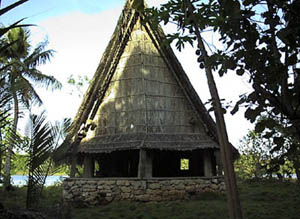
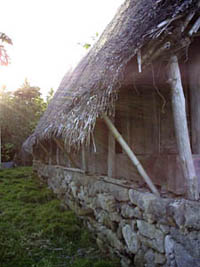 In terms of locations, pebaeys are frequently within a village proper; faluws are always on the shoreline, so that the young men can launch their canoes from here. This is particularly important when it comes to expeditions to catch flying fish. The young men have to undergo various rites in preparation for this venture, and the launching of the expedition itself cannot be viewed by women. In terms of locations, pebaeys are frequently within a village proper; faluws are always on the shoreline, so that the young men can launch their canoes from here. This is particularly important when it comes to expeditions to catch flying fish. The young men have to undergo various rites in preparation for this venture, and the launching of the expedition itself cannot be viewed by women.
If you look carefully (photo at left) you will be able to see the steps that are built into the walls of the foundation. These steps, which consist of elongated stones jutting out from the stone wall, are used to enter into various openings/doors of the faluw.
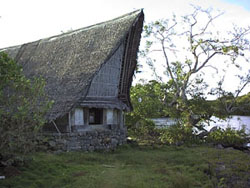 In the old days, the village would kidnap a girl from another village (and hand money over to her father and family) to keep in the faluw. There the boys would become men --- she would be mistress of the faluw and the wife of all the young men. If she became pregnant, no one would know whose child it was, and she would in essence create a new chiefly line. The girl never had to do any cooking or gardening --- that was always supplied by the rest of the village. In the old days, the village would kidnap a girl from another village (and hand money over to her father and family) to keep in the faluw. There the boys would become men --- she would be mistress of the faluw and the wife of all the young men. If she became pregnant, no one would know whose child it was, and she would in essence create a new chiefly line. The girl never had to do any cooking or gardening --- that was always supplied by the rest of the village.
Next: Dinay
|